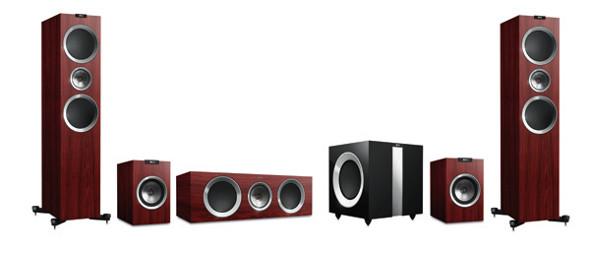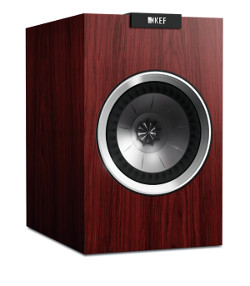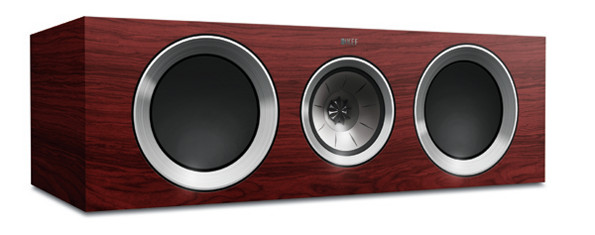KEF R900 Home Theater Speaker System

(Editor's note: see additional comments at the end of this review regarding the ratings and Top Pick status for the KEF 400b subwoofer.)
If you’ve been passionate about audio for more than a few years, or can name five loudspeaker companies with names that don’t rhyme with rose and begin with a B, you’ve certainly heard of KEF. In the late 1980s, KEF introduced a new concentric driver that placed the tweeter in the throat of the midrange cone. Dubbed Uni-Q, the design has been continually refined for over 20 years and remains the centerpiece of most KEF loudspeakers.
KEF today is part of a Hong Kong conglomerate. But while most of its models are now manufactured in China, typically to very high standards like the R Series reviewed here, its design team continues to operate at the original Kent headquarters in the U.K., where the company was founded in 1961.
Son of Blade
 Home Theater first listened to the KEF R Series with a system based on the R300 bookshelf speaker that Mark Fleischmann reviewed back in August 2012. That featured the R600c center channel, a pair of R800ds dipole surround speakers, and a R400b subwoofer. This time around, I opted for the top-of-the-line R900 towers as the mains, and swapped in a pair of direct-radiating R100 bookshelf speakers for surround duties, while utilizing the same center channel speaker and subwoofer. Generally speaking, the R Series avoids the pricey curved cabinets seen in much of the competition these days, but the workmanship is first class. Three finishes are available: gloss piano black, satin walnut, and the gorgeous satin rosewood of our review samples—the latter two are genuine wood veneer. The removable grilles (not used in the listening tests but included in the measurements) are held in place by concealed magnets.
Home Theater first listened to the KEF R Series with a system based on the R300 bookshelf speaker that Mark Fleischmann reviewed back in August 2012. That featured the R600c center channel, a pair of R800ds dipole surround speakers, and a R400b subwoofer. This time around, I opted for the top-of-the-line R900 towers as the mains, and swapped in a pair of direct-radiating R100 bookshelf speakers for surround duties, while utilizing the same center channel speaker and subwoofer. Generally speaking, the R Series avoids the pricey curved cabinets seen in much of the competition these days, but the workmanship is first class. Three finishes are available: gloss piano black, satin walnut, and the gorgeous satin rosewood of our review samples—the latter two are genuine wood veneer. The removable grilles (not used in the listening tests but included in the measurements) are held in place by concealed magnets.
The R Series is said to source its technological DNA from KEF’s current $30,000/pair flagship, the Blade. Much of that technology lies in the latest Uni-Q driver, which operates as a virtual point source. Ribs positioned near the tweeter, together with the mid/woofer cone, create what KEF refers to as a “tangerine” waveguide, optimizing the match between the tweeter’s on- and off-axis response and that of the midrange.
The woofers in the R Series are also said to draw from lessons learned during the Blade’s development, both in refinements to the Uni-Q and the R’s seamless, concave aluminum woofer cones. The R400b subwoofer employs a pair of 9-inch opposing woofers linked together internally by a metal rod—a technique also used in the Blade.
All but one of the full-range speakers in the R Series are three-way vented designs employing dedicated woofers and a 5-inch Uni-Q midrange/tweeter. The exception is the small, two-way R100 surround, which has a slightly different 5.25-inch Uni-Q designed to extend its coverage through the bass range.
One of three floorstanding R Series models, the R900 is the flagship of the range. It includes a pair of 8-inch low-frequency drivers, one each above and below its Uni-Q. Metal outrigger feet, with spikes that can be easily tightened from above, provide added stability.
The R600c center employs two 5-inch woofers, one each on either side of its Uni-Q. The rear ports of all the R Series designs, apart from the port-less, sealed-box subwoofer, may be partially or fully blocked as needed to accommodate each speaker’s low-frequency response to your room. KEF supplies foam plugs for that purpose.
 The Uni-Q design is particularly useful in a center-channel speaker. All crossover networks in a loudspeaker cause the response of each driver to roll off gradually above and below their crossover frequencies. Because this results in response overlaps between what are usually physically separated drivers, interference patterns develop off-axis at and around the crossover point(s). This isn’t generally an issue in a speaker with vertically arrayed drive units, assuming your ears are located at an appropriate height. But in your typical two-way, woofer-tweeter-woofer horizontal center speaker, those interference patterns can produce a significant response dip for off-axis listeners through the crossover region (often around 2-4 kilohertz). This can seriously impair dialogue intelligibility. In the best center-channel speakers, this is addressed by a three-way design, with a midrange and tweeter positioned vertically between two flanking woofers. The Uni-Q also eliminates this concern, but in perhaps an even more elegant fashion with its nearly coincident midrange and tweeter. While the woofers and the Uni-Q will still be horizontally arrayed, this will normally be less of an issue because of the longer wavelengths involved at the lower crossover frequency between these drivers.
The Uni-Q design is particularly useful in a center-channel speaker. All crossover networks in a loudspeaker cause the response of each driver to roll off gradually above and below their crossover frequencies. Because this results in response overlaps between what are usually physically separated drivers, interference patterns develop off-axis at and around the crossover point(s). This isn’t generally an issue in a speaker with vertically arrayed drive units, assuming your ears are located at an appropriate height. But in your typical two-way, woofer-tweeter-woofer horizontal center speaker, those interference patterns can produce a significant response dip for off-axis listeners through the crossover region (often around 2-4 kilohertz). This can seriously impair dialogue intelligibility. In the best center-channel speakers, this is addressed by a three-way design, with a midrange and tweeter positioned vertically between two flanking woofers. The Uni-Q also eliminates this concern, but in perhaps an even more elegant fashion with its nearly coincident midrange and tweeter. While the woofers and the Uni-Q will still be horizontally arrayed, this will normally be less of an issue because of the longer wavelengths involved at the lower crossover frequency between these drivers.
All of the main speakers in the R Series provide two pairs of…um…unique biwirable or biampable binding posts. Instead of the usual strapping bars that connect such posts in other speakers when single wiring is desired, the linkage is internal. Turning external knobs between the posts either connects or separates the terminals. But if you elect to biamp the speakers, be sure to double-check to ensure that you have the terminals separated; unlike those ubiquitous strapping bars, you can’t tell just by looking. Ditto even if you even simply biwire; leave the terminals connected and accidentally reverse the polarity of one of the biwire leads, and you could trash an amp.

The R400b sealed-box subwoofer mates each of its two 9-inch drivers to its own 250-watt, Class D amplifier. A non-defeatable fourth-order low-pass filter is variable from 40 hertz to 140 Hz. There’s also a level control, a switch offering a 40-Hz boost of +6 or +12 decibels, and a two-position (0 and 180 degrees) phase control.
Setup
The R900s were positioned 9 feet apart and about 5 feet out from my room’s 15.5-foot-wide short wall, directly to the left and right of my projection screen (retracted for music listening). The provided spikes were used, but the port plugs were not. The closest sidewall was about 2 feet from the right speaker, and the two speakers were toed-in toward the center listening seat, located about 10 feet from the speakers. The R600c center was placed on a low stand beneath the projection screen, tilted slightly upward. The R100s, used as surrounds in the review system, were located on 25-inch stands near the back of the 25-foot-long room. The R400b subwoofer was placed behind the center speaker and closer to the front wall. An 80-Hz crossover (high and low pass) was selected at the pre/pro when the sub was in use, and the sub’s (non-defeatable) internal crossover was turned to its 140-Hz maximum. The sub’s EQ switch was set to 0.
The system was driven by a Parasound Halo A51 power amp and an Integra DHC-9.8 surround preamp/processor. The latter’s Audyssey room EQ was not used in the review. The eclectic mix of cables that moved in and out of the system, some of them vintage, some fairly new, were from AudioQuest, Monster, Cardas, and Kimber. All of the speakers were single-wired to the amp.
- Log in or register to post comments





































































